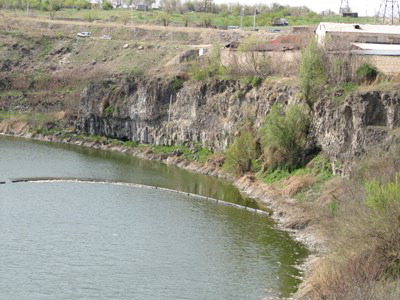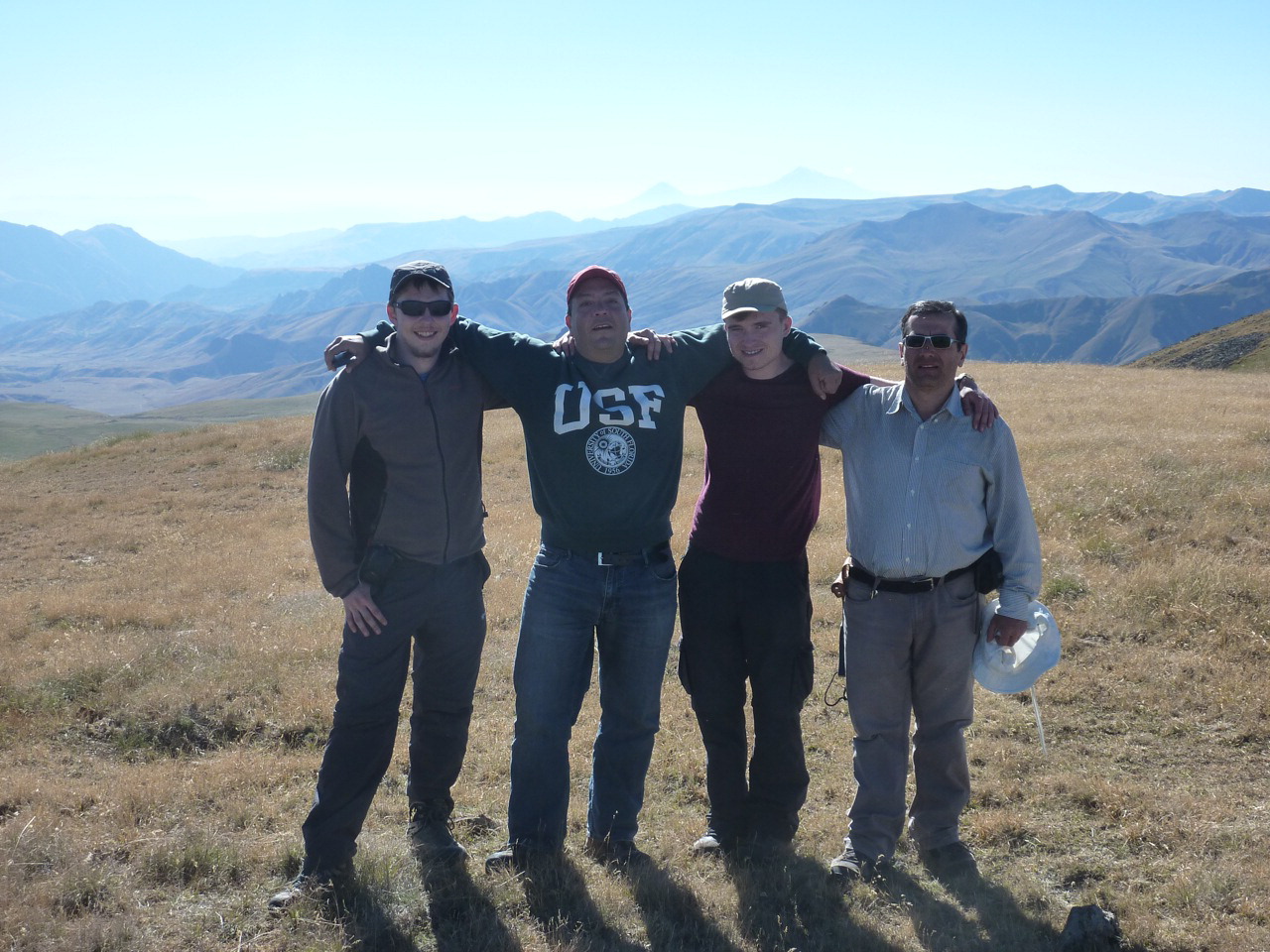Dr. Meliksetian and his colleagues developed a volcano database of the region, including geologic data on the extent, timing, and nature of past volcanic activity in the region. The team added in new data to the database from field work, field mapping of volcanic centers, tephra fallout deposits, ignimbrite units, and lava flows, including data on their thickness, volume estimate, extent, viscosity, and argon-argon dating.
The researchers developed a conceptual model of volcanism in the site region, based on state-of the-art geochemical and petrologic studies, new geochemical data, as well as information about the tectonic setting and geologic history. They also undertook detailed analyses of the recurrence rate and potential magnitude of each volcanic phenomena, including tephra fallout and lava flows, that may impact the infrastructure of the region of the Ararat Valley. From these analyses, the PEER team developed recommendations for Armenian policymakers concerning volcanic hazards in the region. These recommendations included public education and outreach based on project results, enhanced volcano monitoring, including the need for international collaborative efforts to monitor the Ararat volcano system, and development of guidelines for emergency response to volcano crises.
Team members made four visits to the United States to receive training and collaborate with U.S. partner Dr. Charles Connor during the PEER project period, and one team member, Davit Manucharyan, was subsequently accepted into a PhD program at the University of South Florida under Dr. Connor’s supervision, graduating in 2019.
Researchers presented their findings in peer-reviewed papers, in technical presentations at international scientific conferences, including at the European Geosciences Union General Assembly, and at the invitation of International Atomic Energy Agency (IAEA) for a workshop in Manila to discuss hazards for nuclear installations.
The team received an additional $26,000 USD grant from the State Committee of Science of the Republic of Armenia to continue their work. In 2021, Dr. Meliksetian was awarded a new three-year PEER grant under the program’s Cycle 9 to assess geothermal energy resources and natural hazards in Armenia.
PublicationsHripsime Gevorgyan, Christoph Breitkreuz, Khachatur Meliksetian, Arsen Israyelyan, Yura Ghukasyan, Jörg A. Pfänder, Blanka Sperner, Daniel P. Miggins, and Anthony Koppers. 2020. Quaternary ring plain- and valley-confined pyroclastic deposits of Aragats stratovolcano (Lesser Caucasus): Lithofacies, geochronology and eruption history.
Journal of Volcanology and Geothermal Research 401: 106928.
https://doi.org/10.1016/j.jvolgeores.2020.106928 Chih‐Ming Lin, Tai‐Lin Tseng, Khachatur Meliksetian, Arkady Karakhanyan, Bor‐Shouh Huang, Hektor Babayan, Jyr‐Ching Hu, Mikayel Gevorgyan, Shuo‐Fen Chang, and Ara Levonyan. 2020. Locally thin crust and high crustal VP/VS ratio beneath the Armenian volcanic highland of the Lesser Caucasus: A case for recent delamination.
Journal of Geophysical Research: Solid Earth, 125, e2019JB019151.
https://doi.org/10.1029/2019JB019151 Hripsime Gevorgyan, Alexander Repstock, Bernhard Schulz, Khachatur Meliksetian, Christoph Breitkreuz, and Arsen Israyelyan. 2018. Decoding a post-collisional multistage magma system: The Quaternary ignimbrites of Aragats stratovolcano, western Armenia.
Lithos 318–319: 267-282.
https://doi.org/10.1016/j.lithos.2018.07.024 Khachatur Meliksetian, Ivan Savov, Charles Connor, Hripsime Gevorgyan, Laura Connor, Gevorg Navasardyan, Davit Manucharyan, Ruben Jrbashyan, and Yura Ghukasyan. 2016. Violent Explosive Eruptions in the Ararat Valley, Armenia and Associated Volcanic Hazards.
Geophysical Research Abstracts 18, EGU2016-608.
Ivan Savov, Khachatur Meliksetian, Charles Connor, Arkadi Karakhanian, Patrick Sugden, Gevorg Navasardyan, Ralf Halama, Osamu Ishizuka, Laura Connor, and Sergei Karapetian. 2016. Evolution of Pleistocene to Holocene eruptions in the Lesser Caucasus Mts: Insights from geology, petrology, geochemistry and geochronology.
Geophysical Research Abstracts 18, EGU2016-6377.
Khachatur Meliksetian, Charles Connor, Ivan Savov, Laura Connor, Gevorg Navasardyan, Davit Manucharyan, Yura Ghukasyan, and Hripsime Gevorgyan. 2015. Conceptual model of volcanism and volcanic hazards of the region of Ararat valley, Armenia.
Geophysical Research Abstracts 17, EGU2015-11230.
Khachatur Meliksetian, Iain Neill, Mark Allen, and Gevorg Navasardyan. 2015. Petrogenesis of mafic magmatism in Arabia-Eurasia collision zone: valley filling flows in Armenia.
Geophysical Research Abstracts 17, EGU2015-4518.
R.T. Jrbashyan, Kh.B. Meliksetian, Y.G. Ghukasyan, H.P. Gevorgyan, I. Savov, S.H. Karapetyan, G.Kh. Navasardyan, and D.A. Manucharyan. 2015. The Plinian Eruption of Irind Volcano (Aragats Volcanic Region, Armenia).
Proceedings of the National Academy of Sciences of the Republic of Armenia: Earth Sciences 68(1): 3-21.
I. Neill, Kh. Meliksetian, M.B. Allen, G. Navasardyan, and K. Kuiper. 2015. Petrogenesis of Mafic Collision Zone Magmatism: The Armenian Sector of the Turkish-Iranian Plateau.
Chemical Geology 403: 24-41.
https://doi.org/10.1016/j.chemgeo.2015.03.013 Hetu Sheth, Khachatur Meliksetian, Hripsime Gevorgyan, Arsen Israyelyan, and Gevorg Navasardyan. 2015. Intracanyon Basalt Lavas of the Debed River (Northern Armenia), Part of a Pliocene–Pleistocene Continental Flood Basalt Province in the South Caucasus.
Journal of Volcanology and Geothermal Research 295: 1-15.
https://doi.org/10.1016/j.jvolgeores.2015.02.010 Khachatur Meliksetian, Ivan Savov, Charles Connor, Ralf Halama, Ruben Jrbashyan, Gevorg Navasardyan, Yura Ghukasyan, Hripsime Gevorgyan, Davit Manucharyan, Osamu Ishizuka, Xavier Quidelleur, and Aurélie Germa. 2014. Aragats stratovolcano in Armenia - volcano-stratigraphy and petrology.
Geophysical Research Abstracts 16, EGU2014-567-2.
Khachatur Meliksetian, Iain Neill, Mark Allen, and Gevorg Navasardyan. 2014. Plateau basaltic volcanism in a syn-collision setting (South Caucasus).
Geophysical Research Abstracts 16, EGU2014-6703.
Ivan Savov, Khachatur Meliksetian, Ralf Halama, Gevorg Navasardian, Chuck Connor, Massimo D’Antonio, Samuele Agostini, Osamu Ishizuka, Sergei Karapetian, and Arkadi Karakhanian. 2014. Collision zone magmatism aids continental crustal growth.
Geophysical Research Abstracts 16, EGU2014-2235.






